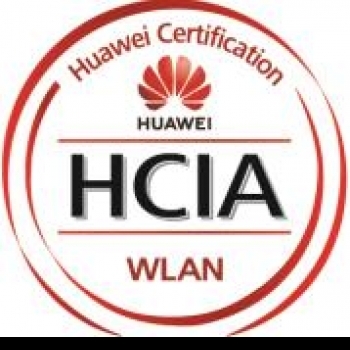
Pré-Requisitos
- Familiaridade com sistemas operacionais de PC.
- Conhecimentos básicos de tecnologia de comunicações e redes.
- Certificação HCIA (R&S) ou conhecimentos equivalentes.
Huawei Certified ICT Associate

Este curso prepara o participante para os desafios encontrados na implementação, operação e manutenção de redes WLAN de alta performance em pequeno e médio portes.
Redes sem fio capazes de suportar serviços de voz, segurança, storage, cloud, entre outros. Durante este curso, o participante aprenderá a instalar e configurar redes com AP´s (Access Points) em formatos isolado (FAT) ou associados a controladoras (FIT).
Modelos de rádios, perfis de segurança e usuários configurados na controladora são outros assuntos que compõem este treinamento. Complementa este treinamento, a força da solução de Wlan da Huawei, já validada por muitos anos de experiência em todos os tipos de enlaces de rádio operados pela linha Carrier desta gigante chinesa de tecnologia.
WLAN Historical Overview
Introduction to wireless networks
What is WLAN
WLAN development
WLAN applications
WLAN Standards Bodies
State Radio Regulation of China
FCC
ETSI
IEEE
Wi-Fi
IETF
WAPI
WLAN RF Principles Introduction
WLAN RF basics
WLAN RF principles
WLAN RF characteristics
WLAN Frequency Bands
Frequency and channel introduction
2.4GHz bands
5GHz bands
Other technology
Huawei WLAN Product Introduction
Huawei WLAN equipment solution introduction
Huawei WLAN equipment application
Huawei WLAN equipment power supply mode introduction
VRP Introduction and Basic Configuration
Introduce the Huawei VRP
Configuring basic AC attributes
AC and AP software upgrade
The basic operation of the AC
Use hype terminal to connect equipment
Modify the Device Name
Configuring the console user interface
Configuring the VTY user interface
Checking the configuration
Reboot the device
WLAN Topologies Introduction
Basic elements of IEEE 802.11
WLAN topologies introduction
802.11 Protocol Introduction
802.11a/b/g protocol introduction
802.11n protocol introduction
802.11 Physical Layer Technology
802.11 physical layer basics
802.11 physical layer technology Introduction
CAPWAP Fundamentals
AP technology introduction
CAPWAP tunnel introduction
WLAN Networking Introduction
WLAN Network Mode
Forward mode introduction
The application of VLAN in WLAN
WLAN Network Configuration
WLAN configuration roadmap
WLAN Layer 2 Network Configuration
Configure AC and AP to be Connected
Configure global parameters on the AC
Configure the APs go online
Configure WLAN-ESS interfaces
Configure radio-profile, security-profile, traffic-profile and service-set
Configure data forward-mode
Configure VAPs and deliver configuration to the APs
Huawei WLAN Product Features Introduction
The basic characteristics of Huawei WLAN product
The key characteristics of Huawei WLAN product
WLAN Roaming
Roaming concept introduction
Roaming basic principle Introduction
Roaming application scenarios
WLAN Security Introduction
WLAN Security threat introduction
WIDS/WIPS introduction
AAA introduction
WLAN Access Security and Configuration Introduction
WLAN authentication technology
WLAN encryption technology
WLAN access security policy
WLAN Access Security Configure
Configure AC6605 access security
Configure a RADIUS server template
Configure WPA authentication
Configure WPA2 authentication
Configure different Encryption
02.11 MAC Layer Introduction
802.11 frames
Data frames
Control frames
Management frames
802.11 Media Access Control
802.11 media access control Mechanism
WLAN media access process
Huawei WLAN QoS Introduction
QoS and Service Model
WMM-profile introduction
Traffic-profile introduction
Antenna
Antenna concept introduction
Antenna basics
Antenna parameters introduction
Other device introduction
WLAN Layer 3 Network Configuration
Configure data forward-mode
Configure AC and AP to be connected
VLAN planning and allocate in Network
Make the APs gone online
Configure WLAN-ESS interfaces
Configure Radio, security-profile, traffic-profile and service-set
Configure VAPs and deliver configuration to the APs
WLAN Basic Network Planning Introduction
The basic flow of WLAN planning
WLAN signal interference introduction
Huawei load balancing technology
WLAN Planning Scheme and Typical Cases Introduction
WLAN typical application scenario
WLAN planning flow
Indoor AP typical cases
Indoor distributed AP typical cases
Outdoor AP typical cases
Huawei WLAN Planner
Huawei WLAN planner basic function
Plan Huawei WLAN
eSight Function and Wizard Configuration Introduction
eSight introduction
Configure WLAN business by wizard
Manual configure WLAN business use eSight
Configure basic parameters on the AC
Configure AP online
Configure AP profile
Configure radio profile
Configure ESS profile
Configure AP regions
eSight WLAN Maintenance
Manage and maintain WLAN
Operation demonstration
WLAN Troubleshooting
Troubleshooting methods introduction
Common diagnostic commands and Tools Introduction
WLAN common troubleshooting
© 4Bios
by neritVocê ainda pode se inscrever em nossos cursos e interagir com nossas redes sociais com total segurança.
